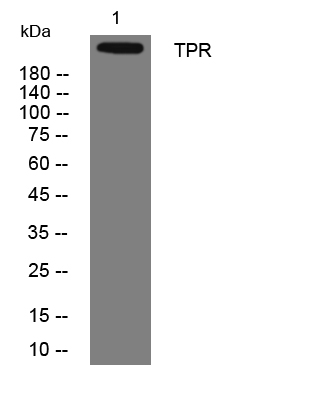TPR rabbit pAb
- Catalog No.:YT6915
- Applications:WB
- Reactivity:Human;Rat;Mouse;
- Target:
- TPR
- Fields:
- >>Nucleocytoplasmic transport;>>Amyotrophic lateral sclerosis;>>Pathways in cancer;>>Thyroid cancer
- Gene Name:
- TPR
- Protein Name:
- TPR
- Human Gene Id:
- 7175
- Human Swiss Prot No:
- P12270
- Immunogen:
- Synthesized peptide derived from human TPR AA range: 2191-2241
- Specificity:
- This antibody detects endogenous levels of TPR at Human
- Formulation:
- Liquid in PBS containing 50% glycerol, 0.5% BSA and 0.02% sodium azide.
- Source:
- Polyclonal, Rabbit,IgG
- Dilution:
- WB 1:500-2000
- Purification:
- The antibody was affinity-purified from rabbit antiserum by affinity-chromatography using epitope-specific immunogen.
- Concentration:
- 1 mg/ml
- Storage Stability:
- -15°C to -25°C/1 year(Do not lower than -25°C)
- Molecular Weight(Da):
- 260kD
- Background:
- This gene encodes a large coiled-coil protein that forms intranuclear filaments attached to the inner surface of nuclear pore complexes (NPCs). The protein directly interacts with several components of the NPC. It is required for the nuclear export of mRNAs and some proteins. Oncogenic fusions of the 5' end of this gene with several different kinase genes occur in some neoplasias. [provided by RefSeq, Jul 2008],
- Function:
- disease:Chromosomal aberrations involving TPR are a cause of thyroid papillary carcinoma (PACT) [MIM:188550]. Intrachromosomal rearrangement that links the 5'-end of the TPR gene to the protein kinase domain of NTRK1 forms the fusion protein TRK-T1. TRK-T1 is a 55 kDa protein reacting with antibodies against the carboxy terminus of the NTRK1 protein.,disease:Involved in tumorigenic rearrangements with the MET or RAF genes.,function:Component of the cytoplasmic fibrils of the nuclear pore complex implicated in nuclear protein import. Its N-terminus is involved in activation of oncogenic kinases. Plays a role in the mitotic spindle checkpoint.,PTM:Phosphorylated upon DNA damage, probably by ATM or ATR.,subcellular location:The assembly of the NPC is a stepwise process in which Trp-containing peripheral structures assemble after other components, including p62. Detected at kinetochores duri
- Subcellular Location:
- Nucleus . Nucleus membrane ; Peripheral membrane protein ; Nucleoplasmic side . Nucleus envelope . Nucleus, nuclear pore complex . Cytoplasm . Cytoplasm, cytoskeleton, spindle . Chromosome, centromere, kinetochore . Nucleus membrane ; Peripheral membrane protein ; Cytoplasmic side . Detected as discrete intranuclear foci with IFI204 (By similarity). In interphase, localizes to the nucleoplasmic side of the nuclear pore complex (NPC) core structure, forming a fibrous structure called the nuclear basket. Detected exclusively to the cytoplasmic margin of NPC (PubMed:7798308). Docking to the inner nucleoplasmic side of the NPC is mediated through binding to nucleoporins. Anchored by NUP153 to the NPC. The assembly of the NPC is a stepwise process in which Trp-containing peripheral structures a
- Expression:
- Expressed in esophagus, ovary, liver, skin, smooth muscles, cerebrum and fetal cerebellum (at protein level). Highest in testis, lung, thymus, spleen and brain, lower levels in heart, liver and kidney.
- June 19-2018
- WESTERN IMMUNOBLOTTING PROTOCOL
- June 19-2018
- IMMUNOHISTOCHEMISTRY-PARAFFIN PROTOCOL
- June 19-2018
- IMMUNOFLUORESCENCE PROTOCOL
- September 08-2020
- FLOW-CYTOMEYRT-PROTOCOL
- May 20-2022
- Cell-Based ELISA│解您多样本WB检测之困扰
- July 13-2018
- CELL-BASED-ELISA-PROTOCOL-FOR-ACETYL-PROTEIN
- July 13-2018
- CELL-BASED-ELISA-PROTOCOL-FOR-PHOSPHO-PROTEIN
- July 13-2018
- Antibody-FAQs
- Products Images

- Western blot analysis of lysates from SW480 cells, primary antibody was diluted at 1:1000, 4°over night



